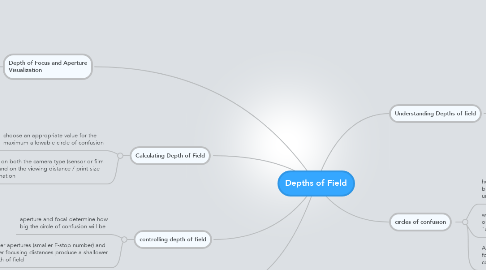Depths of Field
by mario almaraz

1. controlling depth of field
1.1. aperture and focal determine how big the circle of confusion will be
1.2. Larger apertures (smaller F-stop number) and closer focusing distances produce a shallower depth of field
2. Focal Legth and Depth of Field
2.1. Longer focal lengths can cause a shallower depth of field because they enlarge the background relative to the foreground (due to their narrower angle of view)
3. Calculating Depth of Field
3.1. choose an appropriate value for the maximum allowable circle of confusion
3.2. based on both the camera type (sensor or film size), and on the viewing distance / print size combination
4. Depth of Focus and Aperture Visualization
4.1. the distance over which light is focused at the camera's sensor
4.2. when an object is in focus, light rays originating from that point converge at a point on the camera's sensor
4.3. If the light hits the camera at different locations, it causes it to be out of focus
5. Understanding Depths of field
5.1. Depth of field refers to the range of distance that appears acceptably sharp
5.2. varies on camera type/aperture and focusing
5.3. it occurs in a gradual transition
6. circles of confusion
6.1. how much a point needs to be blurred in order to be perceived as unsharp
6.2. when we can see the "circle of confusion",it's outside the depth of field and no longer "acceptably sharp"
6.3. A different maximum circle of confusion applies for each print size and viewing distance combination


